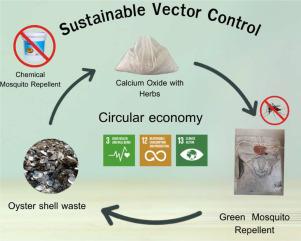牡蛎壳废弃物对埃及伊蚊幼虫生物防治的循环经济价值评价
Q2 Environmental Science
引用次数: 0
摘要
登革热由登革热病毒引起,主要由埃及伊蚊传播,在热带和亚热带地区仍然是一个重大的健康威胁。在泰国,特别是在罗勇省塔马市,登革热的发病率仍然高得惊人,因此必须制定有效和可持续的蚊虫控制战略。本研究探讨了牡蛎壳废物作为一种可持续的杀幼虫剂替代传统化学驱蚊剂(如有机磷酸酯基灭蚊剂)的价值,牡蛎壳废物是一种丰富的海洋副产品。根据循环经济原则,该研究涉及与Thap Ma社区合作开发和评估从处理过的牡蛎壳中提取的灭蚊幼虫产品。对四种配方进行了测试,其中配方1(不含草药添加剂)和配方4(含姜黄)因其简单、易于使用和杀幼虫效果而显示出最大的潜力。环境和社会经济评估显示出良好的成果,包括生态效率得分为666.67,社会投资回报率(SROI)为19.53,估计每年减少温室气体排放0.0143吨二氧化碳当量。这些发现支持了以牡蛎壳为基础的杀幼虫剂作为绿色驱蚊剂的开发,这是一种生态友好的、社区驱动的媒介控制解决方案。本文章由计算机程序翻译,如有差异,请以英文原文为准。

Circular economy valorization of oyster shell waste for biological control of Aedes aegypti mosquito larvae
Dengue fever, caused by the dengue virus and transmitted primarily by Aedes aegypti mosquitoes, remains a significant health threat in tropical and subtropical regions. In Thailand, particularly in Thap Ma Municipality, Rayong Province, the incidence of dengue fever remains alarmingly high, necessitating the development of effective and sustainable mosquito control strategies. This study examines the valorization of oyster shell waste, a plentiful marine by product, as a sustainable larvicide alternative as a green mosquito repellent to conventional chemical mosquito repellent, such as organophosphate-based Abate. Aligned with circular economy principles, the research involved collaboration with the Thap Ma community to develop and evaluate mosquito larvae elimination products derived from treated oyster shells. Four formulations were tested, with Formula 1 (without herbal additives) and Formula 4 (with turmeric) demonstrating the highest potential due to their simplicity, ease of use, and larvicidal efficacy. Environmental and socio-economic assessments revealed promising outcomes, including an eco-efficiency score of 666.67, a Social Return on Investment (SROI) of 19.53, and an estimated reduction in greenhouse gas emissions of 0.0143 tons CO2-equivalent per year. These findings support the development of oyster shell-based larvicides as a green mosquito repellent, an eco-friendly, community-driven solution to vector control.
求助全文
通过发布文献求助,成功后即可免费获取论文全文。
去求助
来源期刊

Environmental Challenges
Environmental Science-Environmental Engineering
CiteScore
8.00
自引率
0.00%
发文量
249
审稿时长
8 weeks
 求助内容:
求助内容: 应助结果提醒方式:
应助结果提醒方式:


